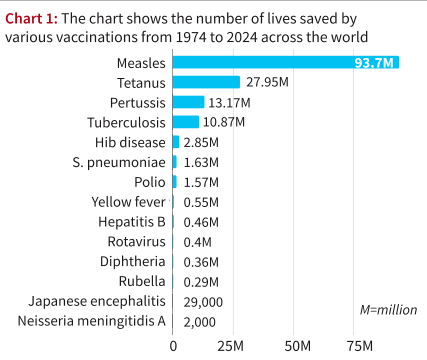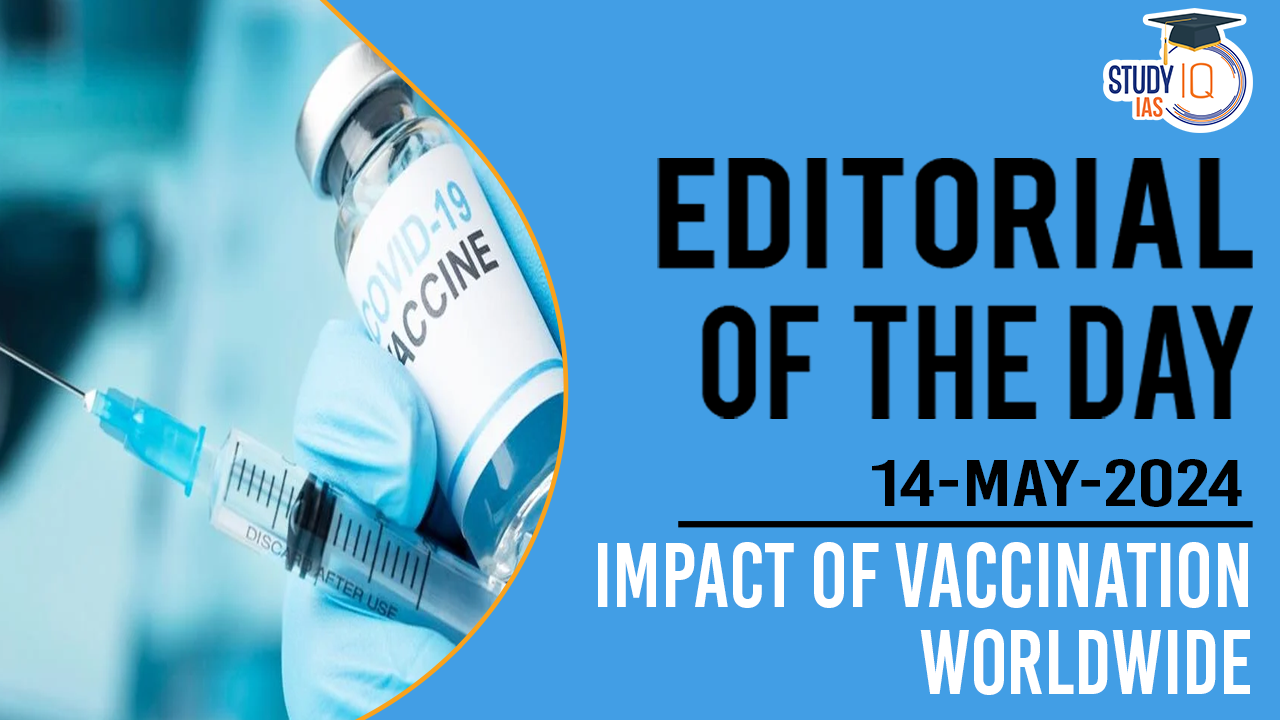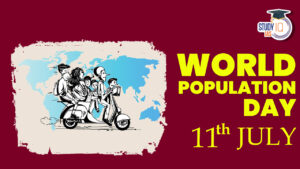Table of Contents
Context
- A new study published in the Lancet highlighted the remarkable impact of vaccinations in saving the lives of an estimated 150 million children over the past 50 years.
- Measles vaccination alone has been responsible for saving 60% of these lives, underscoring the importance of immunisation programs in reducing child mortality.
Key Findings of Lancet Study for Vaccination
- Measles Vaccination: 94 million lives saved, the highest among all vaccines.
- Tetanus Vaccination: 27.9 million lives saved.
- Whooping Cough (Pertussis) Vaccination: 13.17 million lives saved.
- Tuberculosis Vaccination: 10.87 million lives saved.

Reduction in Infant Mortality
- Infant mortality rates have declined from about 10% in 1974 to 3% in 2024.
- Vaccinations contribute to 40% of this decline.
Progress in Vaccination Coverage
| Disease | Data |
| Measles |
|
| DTP3 (Diphtheria, Pertussis, Tetanus) |
|
Global Efforts and Challenges
- Expanded Programme on Immunization (EPI): Established by the World Health Assembly, the decision-making body of the WHO in 1974, led to a significant rise in vaccination rates.
- Gavi, the Vaccine Alliance: Formed in 2000, helped address gaps in vaccination coverage, particularly in Africa and Asia.
Remaining Challenges
Despite progress, vaccine-preventable diseases still cause significant mortality:
- Tuberculosis causes over a million deaths annually.
- Measles, tetanus, whooping cough, meningitis, and hepatitis B collectively result in hundreds of thousands of deaths each year.
Call for Universal Vaccination
- Increased Investment: Governments need to invest more in universal immunisation programs.
- Coordination: Enhanced coordination is required to ensure vaccine availability and accessibility.
- Addressing Vaccine Hesitancy: Efforts to address vaccine scepticism and misinformation are crucial for achieving universal coverage.
About Expanded Programme on Immunization (EPI)
- Launched in 1974, following the near-eradication of smallpox.
- Aimed to leverage existing immunisation infrastructure and trained personnel to expand vaccine benefits.
- Ensures universal access to all relevant vaccines for all populations across the life course.
- Initially focused on protection against six childhood vaccine-preventable diseases: Bacillus Calmette-Guérin (BCG), diphtheria, pertussis, tetanus, polio, and measles1.
- Now includes vaccinations for older children, adolescents, and adults, expanding beyond the initial six diseases.
- Currently recommends 13 vaccines, including newer ones like Haemophilus influenza type B (Hib), Hepatitis B (HepB), rubella, pneumococcal disease (PNC), rotavirus (Rota), human papillomavirus (HPV), and COVID-19 for adults.
In India
- The Expanded Programme on Immunization was launched in 1978.
- It was renamed as Universal Immunization Programme in 1985 when its reach was expanded beyond urban areas.
- In 1992, it became part of the Child Survival and Safe Motherhood Programme.
- In 1997 it was included in the ambit of the National Reproductive and Child Health Programme.
- The Universal Immunization Programme is an integral part of the National Rural Health Mission (launched in 2005).
Success Story
Rising Immunisation Coverage
- Global Progress: Since the 1970s, immunisation coverage among children has increased significantly. In the early 1970s, only about 5% of children in low- and middle-income countries received three doses of the DPT vaccine.
- By 2022, this number had surged to 84% globally.
- Success in India: In India, the percentage of children receiving the recommended vaccines has consistently increased over the years, reaching 76% during 2019-2021.
Impact on Public Health
- Eradication and Elimination of Diseases: The use of vaccines has led to the eradication of smallpox and the elimination of polio from all but two countries. Many other vaccine-preventable diseases are now rare.
- Lives and Costs Saved: Vaccination programs have saved millions of lives and prevented billions of hospital visits and hospitalizations. Economic analysis suggests that every dollar spent on vaccinations yields a return of seven to 11 times the investment.
Dominance in Public Health Programs
- High Coverage: Immunisation programs have achieved higher coverage rates than almost any other health initiative in nearly all low- and middle-income countries, including India.
- Public Sector Dominance: Despite the significant role of the private sector in overall health services in countries like India, where they provide nearly two-thirds of such services, the public sector delivers 85% to 90% of all vaccinations.


 World Population Day 2025, Themes, Histo...
World Population Day 2025, Themes, Histo...
 Special Intensive Revision (SIR) in Biha...
Special Intensive Revision (SIR) in Biha...
 List of Military Exercises of India 2024...
List of Military Exercises of India 2024...





















